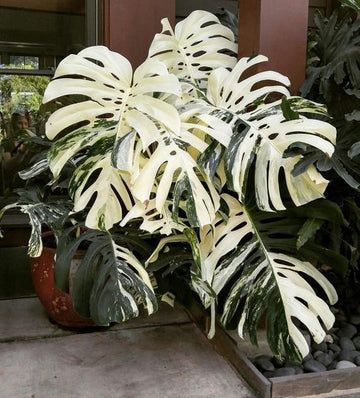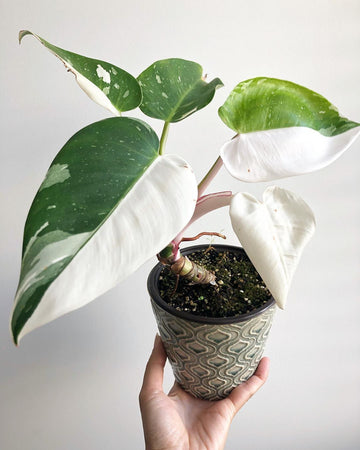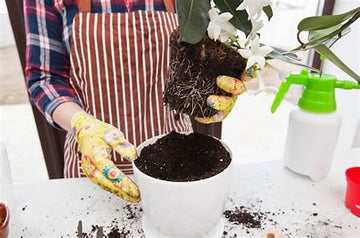Monstera is undoubtedly one of the most beautiful and low-maintenance plants around. The unique "Swiss cheese" holes in the leaves make them stand out. This houseplant is a must-have for any plant parent!
 There are some places where Monstera Deliciosa is called a "fruit salad plant" due to its sweet, tropical fruit. It is native to Central and South America, where its fruit is highly prized and used in traditional dishes and drinks.
There are some places where Monstera Deliciosa is called a "fruit salad plant" due to its sweet, tropical fruit. It is native to Central and South America, where its fruit is highly prized and used in traditional dishes and drinks.
If you have a busy lifestyle or are a forgetful plant parent, Monstera is easy to maintain and suits well for you. There are some Monsteras that can grow quite large, so they may need a bit more space to be able to showcase their beauty. You can add a touch of tropical rainforest vibe to your living room or office with this plant.
Here are some tips and tricks to help you take care of your Monstera and make your home feel like a jungle.
Monstera care: 10 expert tips for growing it successfully
- Keep your Monstera in bright indirect light for the best growth. Avoid direct sunlight, which can burn its leaves.
- Water it consistently, allowing the soil ball to dry out between waterings.
- Monstera is sensitive to overwatering. If you doubt it's the right time for new watering, remember that dry soil is better than moist soil.
- Ensure your soil mix is well-draining and rich in nutrients, such as peat moss, perlite, and compost.
- Fertilise it monthly during the growing season with a balanced liquid fertiliser, following the instructions on the label.
- Regularly check for pests, such as spider mites or mealybugs, and treat them with an appropriate insecticide if needed.
- Prune your Monstera to maintain its shape and size. You can cut off any yellowing or broken leaves, and if it grows too big, you can cut it back.
- Repot your Monstera plant into a slightly larger pot every few years to provide room for growth.
- Provide proper support for your Monstera as it grows and develops aerial roots. Use a trellis or moss pole to help it climb and maintain its beautiful shape.
- Keep your Monstera plant in a room with moderate temperatures and high humidity, as it prefers a tropical environment.
Pay attention to your Monstera plant’s needs and adjust your care routine to keep it healthy and happy. With the proper care, your Monstera will thrive and bring a touch of the tropics to your home.
What’s the story behind the nickname "Swiss Cheese Plant" for Monstera?
The Monstera plant is often called the "Swiss cheese plant" because the holes and grooves that develop in its mature leaves resemble the holes in Swiss cheese.
These holes, called fenestrations, are a natural part of the plant's growth and serve several essential functions. The theory goes that the splits or holes in the Monstera leaves allow the plant to maximise sun capture. The holes in the Monstera leaf help the plant adapt to low light as the holes allow the same leaf area to cover a much wider space, giving them better chances to catch random rays of sunlight. The fenestrations also help the plant to shed excess water during heavy rainfall, preventing it from becoming waterlogged.

The Monstera Deliciosa develops ridges in her leaves rather than completely enclosed holes. A tiny new baby Monstera leaf starts as solid and heart-shaped, but the bigger she grows, the more ridges or splits her leaves get.
In addition to the Swiss cheese plant, split-leaf Monstera is another name that is used for this plant.
Monstera Care
Light
Monstera Deliciosa thrives in bright, indirect light. It prefers not to be in direct sunlight, which can cause the leaves to scorch. In order to grow a plant near a south or west-facing window, the window should be shaded (e.g. with a curtain).
In too little light conditions, the plant may struggle to grow and may become leggy or produce smaller leaves. Yellow leaves can also indicate that it needs more light. To provide enough light for a Monstera deliciosa, try placing it near a window that receives plenty of indirect sunlight or use a grow light to supplement the plant's light needs.
Water
Check the soil moisture before watering your Monstera plant. Allow the soil to dry out slightly between waterings, as over-watering can lead to root rot. A general rule of thumb is to water your Monstera plant when the top 2-3 cm of the soil feels dry to the touch.
When in doubt about watering, dry soil is better than wet soil. Your Monstera plant can tolerate occasional missed watering and will forgive you for forgetting a few times. If water drops appear on the leaves, this is a sign of overwatering. Yellowing of the leaves can also indicate an incorrect watering regime.
Use lukewarm water and water at the base of the plant, avoiding getting the leaves wet to prevent leaf spot. Avoid watering your Monstera plant with cold water, as it can shock the plant and cause leaf damage.
Good tip! You can try bottom-watering your Swiss cheese plant. Simply fill a container with lukewarm water and place your Monstera in the water. Allow the water to be absorbed for several minutes - it will absorb as much water as it needs and no more. It's still important to water the soil from the surface from time to time as this helps to aerate the soil.
Temperature
Monstera plants thrive in a temperature range of 21-29°C, making them ideal for growing indoors in most homes. Although Monstera can tolerate temperature fluctuations fairly well, extreme changes will stress it.
The minimum temperature at that a Monstera will grow healthy is around 16°C, though it will start to slow down in growth and become less active at this temperature. If the temperature drops too low, below 10°C, the plant may become damaged. Cold temperatures can cause the leaves to turn yellow and drop off, and the plant may become stunted or stop growing altogether.
Humidity
It is best to keep the humidity around the plant at around 60-70%, although it can tolerate levels as low as 50%. You can measure air humidity with a hygrometer.
Monstera frequently asked questions (FAQ)
Is Monstera toxic to pets and children?
Yes, the Monstera is poisonous when ingested, so keep her away from small children and pets.
Is Monstera a good indoor plant?
Monsteras are an excellent choice of houseplants primarily because they are easy to grow, require little care, and do well under indoor conditions. You will be able to enjoy the beautiful appearance of this plant for a very long time if you take care of it properly.
Is Monstera high maintenance?
Monstera plants are easy to grow compared to high-maintenance plants. Although Monstera plants don't require much maintenance, they do have a few special care requirements to keep them healthy. Check out the care guide above!
Why are my Monstera plant stems and leaves drooping?
In the case of underwatering, leaves and stems lose their turgor and droop due to the lack of water. The plant recovers quickly to the fast response and timely watering. Meanwhile, it is essential to remember that overwatering and root rot can also result in drooping leaves. Rotten roots can't take up water anymore, and plants dehydrate as a result.
Why are my Monstera leaves yellow?
Generally, overwatering, underwatering, lack of light, nutrient deficiencies, or pest/disease infestations are the causes of yellow leaves. You can resolve the issue by checking the soil moisture level and adjusting your watering schedule accordingly.
Also, ensure the plant is getting enough light, and consider fertilising it with a balanced fertiliser to ensure it gets all the nutrients it needs. If you suspect a pest infestation, try treating the plant with a suitable pest control product or consult a local nursery or plant specialist for further advice.
Why is my Monstera plant not producing split leaves anymore?
Your Monstera plant may no longer produce split leaves for various reasons. There is a possibility that it is simply a natural part of the plant's aging process. Monstera plants often produce fewer split leaves as they age. It's also possible that the plant doesn't get enough light. They need bright, indirect light to grow and produce healthy split leaves. Plants can also lack nutrients, which inhibits healthy growth.
If you want your Monstera to produce more split leaves, place it in a bright, indirect light location and fertilise it regularly. Be sure to give the plant enough water.
How do you make Monstera grow bigger leaves?
If your Monstera's leaves are small, it's possible that it doesn't get enough light. You'll notice your Monstera's leaves growing much larger if you put your plant in a bright spot with indirect light. It is also important to fertilise your plant regularly to keep it healthy.
Is Monstera a Philodendron?
No, Monsteras are not Philodendrons. Although Monstera and Philodendron are both tropical plants native to the Americas, they belong to separate genera and differ in many ways.






